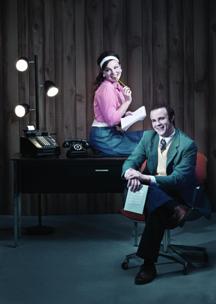OREM — One of the oldest surviving dramatic forms in the Western theatrical tradition is satire. Aristophanes wrote plays that heaped scorn and derision on powerful figures of his day, much as his modern intellectual descendants like Stephen Colbert and the writers of The Simpsons do today. Perhaps satire is so enduring today because it is human nature to enjoy seeing the rich and powerful humbled. The creators of How to Succeed in Business Without Really Trying (composer and lyricist Frank Loesser and playwrights Abe Burrows, Jack Weinstock, and Willie Gilbert) adapted the satirical form to the musical theatre tradition in an attempt to lampoon the big business culture of the early 1960’s. The show was originally a smash hit, running for over four years, thanks to—I imagine—a steady stream of out of town businessmen eager to see their bosses and workplaces (or even themselves) lampooned mercilessly.
How to Succeed tells the story of young J. Pierpont Finch, who comes across a book that teaches him how to climb the corporate ladder to the top. Along the way, he flatters the most influential people, makes the wrong enemies, and falls in love with the right girl, Rosemary Pinkleton. As the main character, Nicholas Grossaint plays a Finch who enthusiastically takes the advice of his guidebook to success seriously, even when there are risks to following the book’s counsel to the letter. Grossaint’s boyish face and energy are perfect for the role of J. Pierpont Finch. I thought he most fully embodied the character in “I Believe in You,” where he clearly showed the character’s self-confidence. Grossaint also gave his character a touch of innocence, which made me feel that he often was not always aware of the machinations of his corporate enemies. This made the tension and conflict in the plot more engrossing than if Finch had been more conscious of others’ motives.
Kelly Coombs Johnson played Finch’s love (and secretary at the company), Rosemary. Although Johnson has an excellent voice (which was gorgeously showcased in “Happy to Keep His Dinner Warm” and “Paris Original”), I felt sorry that she didn’t have more to do in the show. Throughout the play Rosemary does very little; usually she’s just passively waiting for Finch to make the next move in their relationship. There isn’t anything that she could do about her character being underused, and Johnson did the best she could with the material she was given. But I feel that it was a shame that a talented performer was relegated to such a passive lead role.
The supporting cast was enjoyable and quirky, especially Kyle Oram (in the role of Bret Bratt), who embraced his running gag and made it funny throughout the evening. I also thought that Katie Sue Sullivan was pleasant as Smitty, the pragmatic secretary who serves as a foil for Rosemary in the opening scenes. Ben Henderson was probably the strongest male singer in the cast; his rendition of “Grand Old Ivy” felt like it had years of undying loyalty behind it. Finally, public recognition is warranted for Andrew Hansen for his role as the principal antagonist, Bud Frump. Hansen was petulant, insolent, and spoiled in his role, which was a joy to watch, but also helped drive much of the action (especially in the first act). Hansen’s performance made it easy to see why the other characters disliked him so much.
Despite these talented actors, I didn’t feel like this version of How to Succeed was a superb production. The main reason I have this opinion is Dave Tinney‘s direction. I felt that almost every song in the first act was disconnected from the dialogue in the surrounding scene, a tendency that was especially noticeable in “Coffee Break” and “Happy to Keep His Dinner Warm.” I was also disappointed that Tinney didn’t work with the cast to fully exploit the humor in the script. Most jokes in the dialogue got a few chuckles, and many of the funny lines were met with stony silence from the audience. Finally, I don’t believe that Tinney helped his cast embrace the satirical nature of How to Succeed. Although the script is now over 50 years old, Tinney and his actors could have easily played up the humor in the script and made it seem relevant today, especially with anti-big business resentment at a recent high. Unfortunately, he didn’t do this and the piece seemed creaky and dated. However, it wouldn’t be fair for me to leave unmentioned the wonderful musical staging that Tinney had during the overture. It was innovative and interesting to watch, and it was much more fun to watch than sitting in the dark listening to the overture (although I wouldn’t have complained if that’s what Tinney had chosen).
Tinney’s choreography, on the other hand, was interesting, with mechanical, sharp dances in songs like “Coffee Break” and “A Secretary is Not a Toy.” These jerky movements made me see the workers in the company as mindless cogs in a heartless capitalist machine—undoubtedly one of the central themes of the script. I also enjoyed the most traditional dance number in the play (the dance performed on television) and the rousing “Brotherhood of Man,” which was the highlight of the evening. All in all, I definitely found the choreography one of the strongest aspects of this production.
However, I was not impressed by the script. Although it has some funny lines in it, the story is remarkably simple and the characters incredibly flat—even by the standards of musical theatre. Most grating of all is the way that the central conflict in the story is resolved, which requires the audiences to swallow all of the most clichéd conventions of musical theatre without flinching. I’m actually quite shocked that this is one of only 8 musicals to have won a Pulitzer Prize for drama. I also thought that the singing was a little lackluster. The Noorda Theater is not large, yet the cast struggled to fill the space with their voices, even in large group songs like “Paris Original,” “The Company Way,” and “A Secretary is Not a Toy.” This may be, perhaps, because music director Kelly DeHaan did not help the cast create a unified sound. I found many harmonies to be discordant and some solo singing to sound odd and off key (such as in “Heart of Gold”).
Finally, it’s important to mention the visual aspects of Utah Valley University’s production. From the instant I walked into the theater, I adored Brian Healy and Stephen Purdy‘s set. The color scheme and geometric shapes of the entire set evoked the pinnacle of early 1960’s architecture and taste. Moreover, the set (which permitted a theater in the round seating style) was remarkably versatile. It gave me the feeling of a sea of cubicles and offices in a large skyscraper, without having a single door on hinges or a cubicle wall. I also thought that Michael Gray‘s lighting design was effective. It helped direct audience attention to the proper place on stage (important in theater in the round), but also held visual surprises (such as during the pirate dance or “Rosemary”).
To conclude, I have to admit that I found this production of How to Succeed in Business Without Really Trying to be quite uneven. Although the cast was immensely talented and the designers produced great work, I don’t feel like they could overcome the problems associated with the overly simple script or Tingey’s disjointed directing of the non-singing aspects of the production. However, I have a history of recommending that UTBA readers see plays that are not often produced in Utah (even when the show is not very good). This is no exception. So, go see UVU’s How to Succeed. If you hold out for a better production of this play in this state, you may have to wait for a long time.






